- Partner programs should ask partners what enablement they need.
- Partner programs should invest in enablement programs for top performers.
- Partner programs should staff their program with channel and solution subject matter experts.
- Partner programs should test and refine enablement tactics and activities.
- Partner programs should create easily consumable enablement resources.
- Partner programs PRMs’ should have deep business intelligence and analytic tools to enable them to instrument their programs’ success.
6 Channel Enablement Best Practices for Partner Programs to Use in 2023
Channel enablement is a key part of any successful partner program. The Lexington Group’s Kristine Stewart puts it simply: “Channel enablement is inextricably tied to your overall program as it drives the success across your programs.”
With this in mind, partner programs must get enablement right. What are the top best practices for channel enablement in 2023? To answer this question, we spoke with six industry experts. Our panelists include:
- Nicole Steele, Global Director of Channel Marketing and Enablement for cloud-first WAN and security company Aryaka Networks
- Will Armstrong, Senior Director of Global Enablement for IT monitoring solutions provider ScienceLogic
- Alison Bergamo, Principal for channel marketing consultancy Bergamo Marketing Group
- Kristine Stewart, Founder and CEO of channel consultancy The Lexington Group
- Kris Blackmon, Chief Channel Officer for channel go-to-market strategy company JS Group
- Heather Tenuto, Chief Revenue Officer for partner relationship management (PRM) and channel management platform provider Zift Solutions
Want to skip ahead? Check out six channel enablement best practices for partner programs to use in 2023:
- Ask Your Partners What Enablement They Need from Your Program
- Invest in Enablement Programs for Top Performing Partners
- Staff Your Partner Program with Channel & Solution Subject Matter Experts
- Test & Refine Partner Enablement Tactics & Activities
- Create Easily Consumable Partner Enablement Resources
- Your PRM Should Have Deep Business Intelligence & Analytic Tools to Enable You to Instrument Your Program’s Success
What is Channel Partner Enablement?
Channel partner enablement is the process of empowering indirect sales partners to sell your products and services. It typically includes training, tools, content, and sales and marketing resources to assist partners with bringing your solutions to market.
A significant portion of channel enablement is sales education and sales training, which includes articulating several points of differentiation to partners, such as:
- Time to deployment and geographical availability
- Solution applications, benefits, weaknesses, misconceptions and objections
- Target customer deal size and verticals
- Minimum and maximum deal term lengths, options and sales cycles
- Support resources and promotions available to end customers
- Sales engineering and sales support resources for partners
Your partners need to be familiar with and able to access this information instantaneously when the right deal for your solution arises.
An enabled channel partner should handle the following activities:
 Understand and articulate your value proposition
Understand and articulate your value proposition- Send marketing campaigns to customers matching your ideal customer profile
- Engage your company in business and market development opportunities
- Manage opportunities from beginning to close
- In some cases, deploy or install solutions in the customer environment
- Educate the customer’s team on the use of the solution
- Promote solution adoption inside the client organization
- In some cases, take and resolve first-level support and trouble-ticket requests from the end customer
What are the Essential Components of Channel Partner Enablement?
We asked our panelists to outline their view of the components of a channel partner enablement program.
Bergamo Marketing Group’s Bergamo says essential components of any channel partner enablement program include:
- Go-to-market tools
- Partner briefings and events
- Digital marketing automation
- Analytics
- Comprehensive learning resources
“Wrapping these components around timely, relevant, digital-first content empowers partners to learn, sell, and accelerate their revenue growth,” says Bergamo.
ScienceLogic’s Armstrong adds that a channel partner enablement program needs to have four main qualities: scalability, simplicity, standardization and support.
“Whatever you build for a partner to accelerate and amplify their ability to sell your products, it must be highly impactful without requiring significant administration,” Armstrong explains. “The onboarding process should [have] concise and simple steps, clearly articulated and readily supported with thoughtful guidance. A vernacular should be created and maintained. Define the industry words you use and the product-specific terminology, so everyone is clear and on the same page. Identify the outcomes expected at each stage and support their success with your partner team.”
The Lexington Group’s Stewart adds a final and potentially most important component. “Being able to measure and identify if programs are working for the partner is critical,” she says.
Why Should Partner Programs Invest in Channel Enablement?
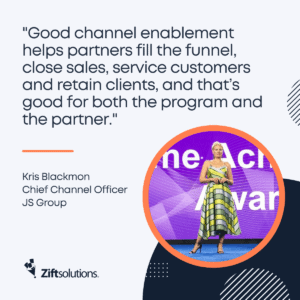 We surveyed our panelists on the benefits of partner programs investing in channel partner enablement. Here are their insights:
We surveyed our panelists on the benefits of partner programs investing in channel partner enablement. Here are their insights:
“We’re all in this business to make money, and proper enablement helps both the vendor and the partner reach that goal faster,” says JS Group’s Blackmon. “Good channel enablement helps partners fill the funnel, close sales, service customers and retain clients, and that’s good for both the program and the partner.”
Blackmon explains:
- “As a vendor, providing great enablement means that in the sales and marketing phase, your partners are fantastic brand advocates and representatives; in the deployment phase, they’re able to adequately service and support your solution; and in the customer support phase, they’re able to consistently push for that renewal or upsell.
- As a partner tasked with marketing, selling and supporting a dozen or more vendors at a time, anything they can do to help you get to cash quicker is a plus. It’s all about efficiency and effectiveness. When enablement hits both marks, you’ve struck gold.”
Aryaka’s Steele also cites the dual benefits of enablement:
- “The benefit of channel enablement for vendors is that when partners are properly enabled, they will promote the vendor that spends time and money enabling them to help their customers and grow their business.
- The benefit of channel enablement for partners is that when they identify a customer and their pain points, they have a better understanding of the vendors’ solution sets and will be able to offer the customer the best match. Enablement means more money in partners’ pockets.”
The Lexington Group’s Stewart points out that partner enablement is a crucial program differentiator. “[S]ome partners that may be evaluating similar solutions from vendors could use enablement as a selection factor,” says Stewart. “They want to have their teams trained to close on [an] opportunity (either alone or co-selling with the vendor) as quickly as easily as possible.”
ScienceLogic’s Armstrong agrees that enablement done right also can attract partners looking for vendors that are easy to work with. “Ease of doing business is probably the most significant differentiator for tech companies when selling through their channels, and enablement is the function that ensures that simplicity translates to scalable impact,” says Armstrong. “When partners can win more without doing more, everyone wins! Channel enablement ensures partners understand the simplified sales motion, the value prop of the solution and how to message it to customers, and the mechanics on how to register and get paid on the deal.”
Bergamo Marketing Group’s Bergamo Bergamo adds that enablement is not only about pushing sales through partners but enabling them to grow their businesses with you.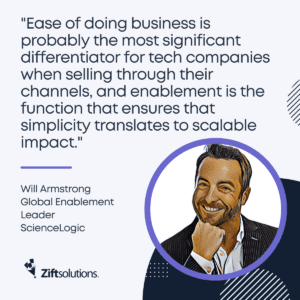
“An effective channel partner enablement program that anticipates and meets the needs of partners and their customers can enhance partner loyalty, revenue generation, brand reputation, and more,” says Bergamo. “Partners benefit from doing business with a vendor that provides them with a strategic view of the complex, ever-changing technology landscape, helps them identify new routes to market, and offers world-class resources and support throughout the sales, implementation and post-sale processes.”
6 Channel Enablement Best Practices for Partner Programs to Use in 2023
What are the best channel enablement strategies? We asked our expert panel and got the six channel enablement best practices partner programs should adopt this year.
1. Ask Your Partners What Enablement They Need from Your Program
Your program should survey partners to see what they need from you. It seems pretty obvious, right? Well, apparently not, according to our panelists.
“This should go unsaid but is often overlooked,” explains JS Group’s Blackmon. “If you want to know what enablement to offer your partners, then ask them. Establishing an honest feedback loop with your partner community is crucial so that you know the challenges they’re facing you can help them solve and the opportunities you can help them take advantage of.”
Blackmon points out that providers tend to crank out materials not tailored to the right partner type. “Too many vendors make the mistake of producing enablement that’s designed to help them, not the partner,” says Blackmon. “You can’t give the same marketing kit to an SMB MSP that you do to an enterprise VAR. They’re very different beasts. You have to listen to your partners when they tell you what they need.”
After you understand what your different partner types need, your team can create enablement materials and activities that are meaningful to each partner. “Everything flows from there,” Blackmon says. “Now you know the training you need to provide, the marketing materials that will be effective, the sales enablement artifacts that will move the needle. If you just listen to your partners, they’ll tell you what they need from you.”
Blackmon also reminds programs that this is an iterative process and not a simple one-and-done check-in. “Make sure you’re taking their pulse on a regular basis, so you get that constant feedback,” Blackmon says.
2. Invest in Enablement Programs for Top Performing Partners
Even large programs typically don’t have the resources to equally enable every partner in their portfolio. You’ll need to pick and choose partners in which to invest resources.
“You want to identify top performers and tier them and find the best programs to make them successful,” explains Aryaka’s Steele. “It also shows the growth options for the other partners in the program. I recommend launching a concierge program where vendors enable top partners with the training, go to market in a unified way and message the combined value proposition.”
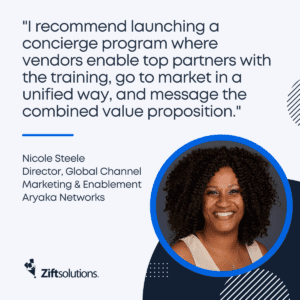 Aryaka, for example, recently launched its elite seller program, which gives top performers access to resources like business development representatives who qualify leads and more.
Aryaka, for example, recently launched its elite seller program, which gives top performers access to resources like business development representatives who qualify leads and more.
But what about partners who aren’t top performers? “You can’t scale that [concierge-level] investment across all partners, but you can offer tiered enablement,” says Steele. “A-level partners can be part of the concierge program while B-level partners are enabled through digital programs that help partners with lead generation but require less investment from the vendor.”
JS Group’s Blackmon says a points program can enable partner tiering. “At JS Group, we’ve been advocates of the points program for partners for years, so that partner activity, not just sales, results in benefits,” says Blackmon. “Consider some version of this when deciding whether a partner is in or out of a program or what tier they’re in. Commitment and engagement are worth lots more in the long term than one large opportunistic sale that happens to get them to their revenue requirement.”
3. Staff Your Partner Program with Channel & Solution Subject Matter Experts
Staff your program with channel account managers who get the channel. It’s well-known that the channel is a tight-knit relationship-driven industry. Your people need to know how the channel works and come to your program with meaningful partner relationships.
JS Group’s Blackmon acknowledges staffing appropriately can be challenging in today’s economic environment, but they can make or break successfully enabling partners. “…I’d say to make sure you’re staffed adequately,” says Blackmon. “I know layoffs are happening as this recession looms, and that’s a valid business decision. But when you bring people into your channel organization, make sure they’re well-versed in [the] channel. Make sure they understand partners. The channel is a different beast and requires a different way of thinking. If your staff doesn’t understand the partner, they won’t be well-equipped to drive success for your channel organization.”
Bergamo Marketing Group’s Bergamo extends the staffing requirement further to focus on solution expertise. “Vendors need to provide resources to help their partners understand the business value of their solutions and encourage them to ask questions,” says Bergamo. “You can have a Ph.D. in information technology and still not understand the nuances of SD-WAN, UCaaS, Cybersecurity Mesh Architecture (CSMA) or Microsoft Azure. Encourage your partners to ask the tough questions and provide them with access to solution experts to team up with them on deals, including offering provider recommendations, quote assessments and win-loss analysis.”
 4. Test & Refine Partner Enablement Tactics & Activities
4. Test & Refine Partner Enablement Tactics & Activities
Assess, assess, assess. You’re unlikely to deliver a world-class enablement program right out of the gate. Plan on evaluating and revising individual campaigns, training courses, marketing pieces, value propositions and more.
“Test ideas,” says ScienceLogic’s Armstrong. “Create effective feedback mechanism[s] and adjust [the] approach as needed. Always drive outcomes with a growth mindset [and] a focus on continuous improvement. Great approaches and ideas can come from anyone in the channel ecosystem [and] the enablement team ensures those ideas get executed and communicated.”
JS Group’s Blackmon agrees, reminding you to test and refine enablement materials in conjunction with your partners, not in a vacuum. “…I’m going to sound like a broken record, but you have to really listen to your partner community,” says Blackmon. “There are a million vendors out there for every type of solution. Partners have unlimited choices, so you need to establish that true relationship of listening and learning so you can give partners what they want and need. It amazes me how many providers just assume they know what their partners need without ever actually hearing it from their lips.”
5. Create Easily Consumable Partner Enablement Resources
Channel partners are always hard-pressed for time and need to be able to engage with your enablement materials easily and quickly.
For example, Bergamo Marketing Group’s Bergamo details the success of short-form video content from her time at Pax8. “Most sales reps are trying to fit learning in between sales calls and closing deals,” says Bergamo. “As Director of Partner Education at Pax8, my colleagues and I launched Pax8 Academy to deliver on-demand, video-first content that partners could consume while waiting to board a flight or log into their next Zoom call. Our first course was ‘How to Succeed in Selling Microsoft.’ This on-demand course was delivered via a series of short videos with a total learning time of approximately two hours. The most valuable module was a five-minute video in which Pax8’s CRO provided tips and insights on how partners could successfully address key Microsoft customer pain points.”
The Lexington Group’s Stewart also notes this same need for easy enablement. “Ensuring that enablement content is provided in a ‘just in time’ fashion is critical,” says Stewart. “Also, the more use of video, mobile applications and keeping the messages in ‘bite-sized’ consumption will be critical – for the success of your program and the experience for your partners.”
 Zift Solutions’ Tenuto points out that resources partners share with customers should be similarly easy to consume. “The enablement materials that make their way to clients also need to be simple,” says Tenuto. “You also have to design them to be understood by the business client, who is typically less educated on the solution than are your partners.”
Zift Solutions’ Tenuto points out that resources partners share with customers should be similarly easy to consume. “The enablement materials that make their way to clients also need to be simple,” says Tenuto. “You also have to design them to be understood by the business client, who is typically less educated on the solution than are your partners.”
Tenuto explains why this is especially important in a real-world scenario: “Since partners are so busy, they may simply forward a piece of collateral and a link to a video to a prospect. If that piece of information requires clarification from you or the partner, the deal can die right then and there. Unfortunately, people often don’t ask questions when they don’t understand; they just move on to another vendor who makes things easier.”
6. Your PRM Should Have Deep Business Intelligence & Analytic Tools to Enable You to Instrument Your Program’s Success
Technology is your friend in tracking the success of your partner enablement program, our panelists note.
“Tools are important,” says Aryaka’s Steele. “A PRM can enable you [to] determine:
- Who closes
- Who has pipeline
- Who is going into the portal
- Who is using the campaigns
You can pull a report, see who’s taking actions that you want and identify which partners to invest resources in, like telesales follow-up so the partner can close more deals. The only other [tool] to do this is through the CRM. And then marketing would need to do a manual marketing audit to see if they are doing anything online.”
Bergamo Marketing Group’s Bergamo echoes the advice on automating processes, adding that this extends beyond reporting to creating the enablement resources and materials. “Vendors should pilot and implement AI-powered sales and marketing tools to help with content creation, lead generation, social media, analytics and more,” says Bergamo. “AI-powered sales and marketing tools can help vendors improve efficiency and ROI through intelligent automation of processes and tasks, empowering their teams to focus on more strategic priorities.”
Partner programs looking to get the most value from their channel partners should consider implementing these enablement practices in 2023.

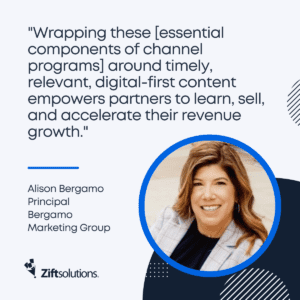 Understand and articulate your value proposition
Understand and articulate your value proposition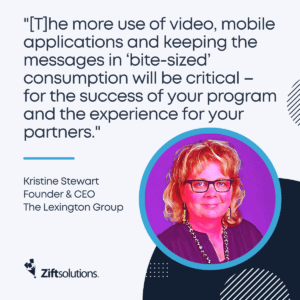 4. Test & Refine Partner Enablement Tactics & Activities
4. Test & Refine Partner Enablement Tactics & Activities


